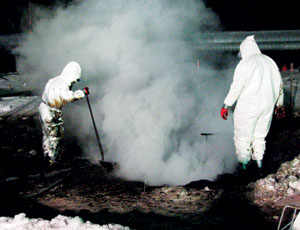Two weeks after an 18-in. three-phase common pipeline ruptured on Alaska’s North Slope, spewing more than 1,000 barrels of crude oil, produced water and natural gas from a 24-in. gash, cleanup workers are “trimming” the tundra by hand and with machinery in subzero temperatures to remove oil and produced water. At ENR press time, they had removed the bulk of the spilled material from the surface of the 8,400-sq-ft affected area, says Steve Rinehart, spokesman for producer BP Exploration Alaska Inc.

Small Bobcat-type bucket loaders removed the snow-oil mixture, and cleanup continued with a warm-water flush and vacuum. Trimming will remove the top several inches of the tundra to pick up material that may have penetrated the ground surface, Rinehart says.
A BP operator discovered the spill in Prudhoe Bay on a routine check in the early morning of Nov. 29. By Dec. 7, cleanup officials had determined the rupture was “consistent with an overpressure scenario, linked to ice plugs forming inside the pipe,” says a BP statement. The pipeline was not in operation at the time of the spill, officials say.
BP and the Alaska Dept. of Environmental Conservation now are investigating separately to understand why ice plugs formed in the pipe and what caused it to break.
“DEC is overseeing the cleanup with the U.S. Environmental Protection Agency and the North Slope Borough,” says Tom DeRuyter, the state DEC’s cleanup coordinator. He could not comment on penalties.

Post a comment to this article
Report Abusive Comment